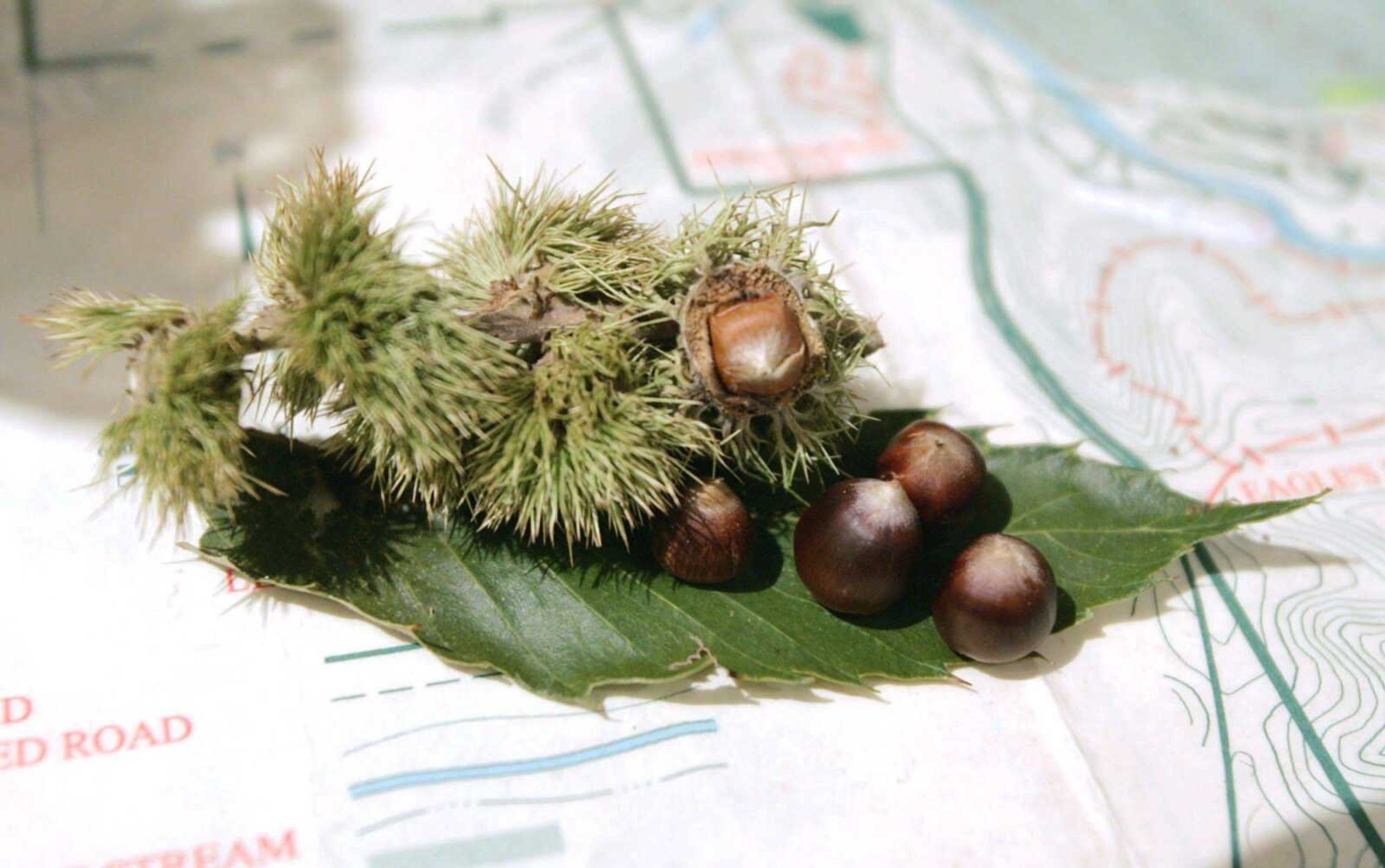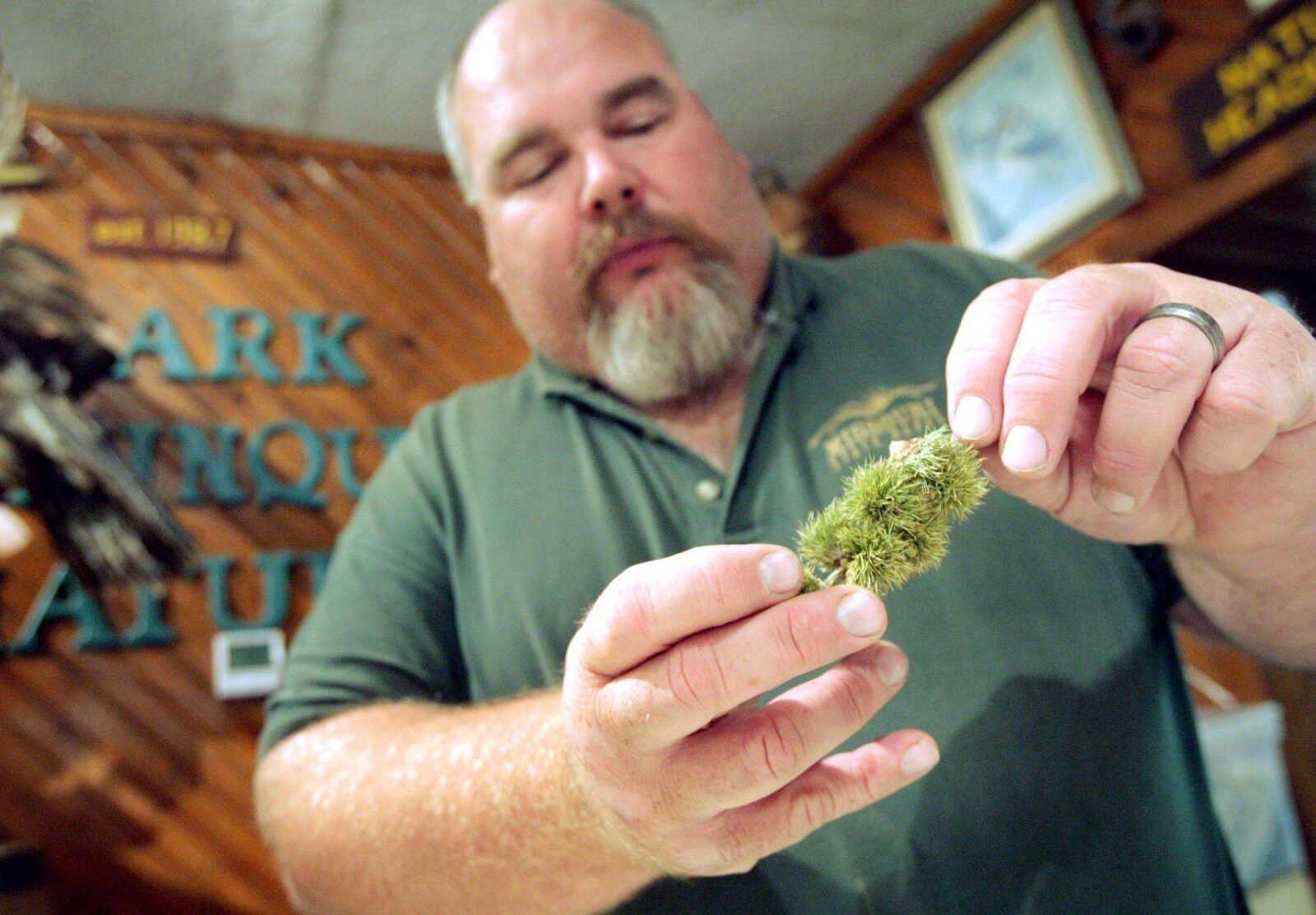Restoring the Ozark chinquapin
CASSVILLE, Mo. -- Each time he fills his orange shoe box with an unlikely treasure collected from the woods, Cheyne Matzenbacher hopes it makes a difference in the future of a species. "I didn't know anything about the Ozark chinquapin when I first started here, but it sparked my interest to the point that I wanted to be a part of it," said Matzenbacher, who by day works as a naturalist at Roaring River State Park's Ozark Chinquapin Nature Center, named for the tree that once flourished across this part of the United States.. ...
CASSVILLE, Mo. -- Each time he fills his orange shoe box with an unlikely treasure collected from the woods, Cheyne Matzenbacher hopes it makes a difference in the future of a species.
"I didn't know anything about the Ozark chinquapin when I first started here, but it sparked my interest to the point that I wanted to be a part of it," said Matzenbacher, who by day works as a naturalist at Roaring River State Park's Ozark Chinquapin Nature Center, named for the tree that once flourished across this part of the United States.
In his off hours, he serves as a board member of the year-old Ozark Chinquapin Foundation, working to plant and cross-pollinate the tree and create public awareness.
"People ask, `Why are we doing this? Why is it important?"' he said.
As Matzenbacher shared details of the species that once covered 40 percent of Missouri and what eventually became of it, he unloaded the shoe box. It required thick gloves and careful handling: The seed husks inside, which were covered in a mass of prickly spines, resembled small, rounded cactuses.

Inside each husk was at least one seed pod, and inside each seed pod was a nut. It is the most nutritious kind of nut in the Ozarks woods for wildlife, far outperforming the white oak and the American chestnut in protein, carbohydrate, fat and trace mineral content.
The Ozark chinquapin also can outproduce most other trees in the forest: A mature one produces 6,000 nuts a year, in contrast with a mature white oak's 2,000 a year.
"People who watch squirrels and other wildlife say the animals step over acorns to get to these," Matzenbacher said.
The nuts also are of great value to Ozark Chinquapin Foundation members who have been working to establish a viable seed base of 100 percent pure Ozark chinquapin trees that are resistant to chestnut blight.
"It all but wiped it from its range," Matzenbacher said.
Among the group members' methods is to painstakingly find and collect the nuts to plant, and they have a narrow time frame in which to do so.
"There is just a two-week period to collect these for our project," Matzenbacher said. "When the squirrels start eating them, you'd better get there quick or they'll be gone."
"People used to shovel these into the backs of their wagons for livestock feed. Now, I'm excited to find this," he said, pointing to his shoe box.
The members also began conducting a complicated and tedious cross-pollination procedure in the Missouri and Arkansas Ozarks.
"We're taking pollen from large Ozark chinquapins that are producing nuts and exhibit some signs of resistance to blight, and are pollinating other trees that show resistance," said Tim Smith, also a naturalist at the Ozark Chinquapin Nature Center and a board member of the Ozark Chinquapin Foundation.
When the trees flower in mid- to late May, members find trees, cut the male flowers off and put them in a brown paper sack to let them dry, Smith explained. Then, they scrape the catkins to get the pollen and freeze it to use the following year.
"The next year we'll bag the female flowers so they can't get pollinated by anything else, and then we introduce the male pollen," Smith said.
"It's complicated, it is tedious and time-consuming, but that's the only way we can do it."
The effort, which was the brainchild of Montauk State Park naturalist Steve Bost, has earned him the nickname "The Johnny Appeseed of the Ozark Chinquapins," Smith said.
Chestnut blight came to the U.S. by way of a tree -- a Chinese chestnut -- that was planted in the Bronx Zoo at the turn of the last century. It spread quickly, at the rate of about 20 miles annually, and in its path left 3 billion dead American chestnut trees.
When it crossed the Mississippi River to the Ozarks, it attacked the Ozark chinquapin, a type of chestnut. The tree also was highly prized among early settlers for its wood, which resisted rot and made excellent railroad ties and fence posts.
Logging practices, combined with the blight, reduced its historical range that included Missouri, Arkansas, Oklahoma, northern Louisiana, and portions of Mississippi and Alabama.
Today, mostly blighted stumps remain. Sprouts emerge from the stumps, many managing to produce nuts, but within four to six years, the blight strikes again and kills the sprouts.
"When we first began, Steve told me, 'You're looking for a ghost,'" Matzenbacher said.
The group has had success, however.
"The ones we're finding now somehow resisted it -- and that's what we want in order to restore it to its original luster," Matzenbacher said. "Now we have a database and have successfully cross-pollinated a tree 19 inches in diameter."
Foundation accomplishments include discoveries of 11 large surviving trees that exhibit levels of blight resistance, the creation of a recovery action plan, and the establishment of test plots in Missouri and Arkansas. The group also has been working to raise public awareness.
To that end, Matzenbacher plans to produce a poster and a digital presentation that are instructional in nature.
"That way, the average person who finds one can follow step-by-step instructions to cross-pollinate," he said. "That will hopefully greatly cut down on our travel." The group also can give seeds to individuals who are interested in helping re-establish the trees.
------
Information from: The Joplin (Mo.) Globe, http://www.joplinglobe.com
Connect with the Southeast Missourian Newsroom:
For corrections to this story or other insights for the editor, click here. To submit a letter to the editor, click here. To learn about the Southeast Missourian’s AI Policy, click here.








